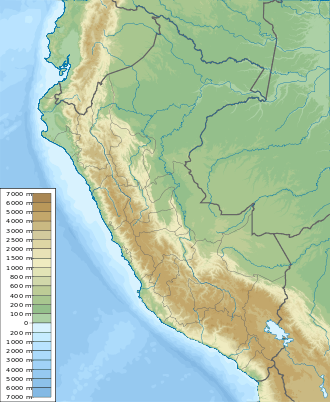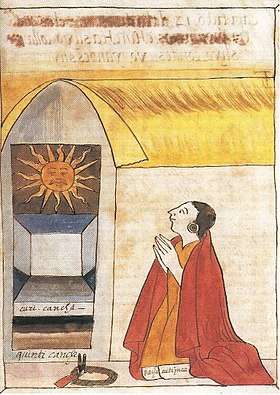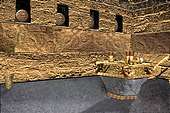Coricancha
Coricancha,[1][2][3][4][5] Koricancha,[6][7][8][9] Qoricancha[10] or Qorikancha[11][12] ("The Golden Temple," from Quechua quri gold; kancha enclosure)[13] was the most important temple in the Inca Empire. It is located in Cusco, Peru, which was the capital of the empire.
Qurikancha | |
Coricancha with Convent of Santo Domingo above | |
 Shown within Peru | |
| Location | Cusco |
|---|---|
| Region | Andes |
| Coordinates | 13°31′12″S 71°58′32″W |
| Type | Sanctuary |
| History | |
| Periods | Late Horizon |
| Cultures | Inca |

History
Originally named Intikancha or Intiwasi,[11] it was dedicated to Inti, and is located at the former Inca capital of Cusco. Most of the temple was destroyed after the 16th-century war with the Spanish conquistadors, as settlers also took it apart to build their own churches and residences. Much of its stonework was used as the foundation for the seventeenth-century Santo Domingo Convent. It was built after the 1650 earthquake destroyed the first Dominican convent.
To construct Coricancha, the Inca used ashlar masonry, building from the placement of similarly sized cuboid stones that they had cut and shaped for this purpose.[14] The use of ashlar masonry made the temple much more difficult to construct, as the Inca did not use any stone with a slight imperfection or break.[14] By choosing this masonry type, the Inca intentionally demonstrated the importance of the building through the extent of the labor necessary to build the structure.[14] Through the arduous labor needed to construct buildings with ashlar masonry, this form of construction came to signify the Inca's imperial power to mobilize and direct local labor forces.[14] The replication throughout Andean South America of Inca architectural techniques, such as those employed at Coricancha, expressed the extent of Inca control over a vast geographic region.[14]
Pachakutiq Inca Yupanqui rebuilt Cusco and the House of the Sun, enriching it with more oracles and edifices, and adding plates of fine gold. He provided vases of gold and silver for the Mama-cunas, nuns or cloistered women, to use in the veneration services. Finally, he took the bodies of the seven deceased Incas and adorned them with masks, head-dresses, medals, bracelets, and sceptres of gold, placing them on a golden bench.[15]:68–69,75
The walls were once covered in sheets of gold,[16]:218–219 and the adjacent courtyard was filled with golden statues. Spanish reports tell of an opulence that was "fabulous beyond belief". When the Spanish in 1533 required the Inca to raise a ransom in gold for the life of their leader Atahualpa, most of the gold was collected from Coricancha.[17]
The Spanish colonists built the Convent of Santo Domingo on the site, demolishing the temple and using its foundations for the cathedral. They also used parts of the building for other churches and residences. Construction took most of a century. This is one of numerous sites where the Spanish incorporated Inca stonework into the structure of a colonial building. Major earthquakes severely damaged the church, but the Inca stone walls, built out of huge, tightly interlocking blocks of stone, still stand due to their sophisticated stone masonry. Nearby is an underground archaeological museum that contains mummies, textiles, and sacred idols from the site.[11]
Inca astronomy

Similarities are found in the semicircular temples found in the Temple of the Sun in Cusco, the Torreon in Machu Picchu, and the Temple of the Sun in Písac. In particular, all three exhibit a "parabolic enclosure wall" of the finest stonework, as Bingham describes it. These structures were also used for similar purposes, including the observation of solstices and Inca constellations.
Within the Milky Way, which the Inca called mayu or Celestial River, the Inca distinguished dark area or clouds, which they called yana phuyu. These were considered silhouettes or shadows of animals drinking from the river water. Amongst the animals named by the Inca, was a llama extended from Scorpius to Alpha Centauri and Beta Centauri, in which those two stars formed the llama's eyes, or llamacnawin. A baby llama, llama-cria, was inverted underneath. To the left of the llamas is a red-eyed fox, atoq, which lies between Sagittarius and the tail of Scorpius. The tail of Scorpius is known as a storehouse, or qullqa. A partridge, yutu, was just below the Southern Cross, and a toad, hamp'atu, to the lower right. A serpent, machaguay, extends off to the right.[18][19][20]
During the Inti Raymi, the Sapa Inca and curacas would proceed from the Haucaypata, where they greeted the rising June solstice sun, to the inner court of the Coricancha. On a bench in the "sun room", the Sapa Inca sat with the mummies of his ancestors. This and other rooms were oriented northeast–southwest, shingled in gold plate, and embedded with emeralds and turquoise. Focusing the sun's rays with a concave mirror, the Sapa Inca would light a fire for the burnt sacrifice of llamas. Children were also sacrificed in certain circumstances; they were brought to Cusco following a ceque and huaca route of tribute.[20]:199–201
The Coricancha is located at the confluence of two rivers. Here, according to Inca myth, is where Manco Cápac decided to build the Coricancha, the foundation of Cusco, and the eventual Inca Empire. According to Ed Krupp, "The Inca built the Coricancha at the confluence because that place represented terrestrially the organizing pivot of heaven."[20]:270–276
Images
 Coricancha, Convent of Santo Domingo, and courtyard (Intipampa)
Coricancha, Convent of Santo Domingo, and courtyard (Intipampa)..jpg) A digital reconstruction of its base during the Inca period
A digital reconstruction of its base during the Inca period- One of the original rooms from the Inca period
 A digital reconstruction of the room when it was filled with gold, according to the description of Inca Garcilaso de la Vega
A digital reconstruction of the room when it was filled with gold, according to the description of Inca Garcilaso de la Vega Ceiling ornament
Ceiling ornament Colonial Cusco School paintings, inside
Colonial Cusco School paintings, inside
See also
- Convent of Santo Domingo, Cusco
- List of buildings and structures in Cusco
- Pedro Cieza de Leon's The Chronicle of Peru
- Inca Garcilaso de la Vega's Comentarios Reales de los Incas
- Felipe Guamán Poma de Ayala's The First New Chronicle and Good Government
- Iperu, tourist information and assistance
- Tourism in Peru
References
- Ring, Trudy; Watson, Noelle; Schellinger, Paul (2013). The Americas: International Dictionary of Historic Places. Routledge. p. 183. ISBN 9781134259304.
- Krupp, E. C. (2012). Echoes of the Ancient Skies: The Astronomy of Lost Civilizations. Courier Corporation. pp. 271–272. ISBN 9780486137643.
- Hyland, Sabine (2011). Gods of the Andes: An Early Jesuit Account of Inca Religion and Andean Christianity. Penn State Press. p. 8. ISBN 0271048808.
- Bauer, Brian S. (1998). The Sacred Landscape of the Inca: The Cusco Ceque System. University of Texas Press. ISBN 9780292792043.
- Bauer, Brian S. (2004). Ancient Cuzco: Heartland of the Inca. University of Texas Press. pp. 139–158. ISBN 9780292792029.
- "Machu Picchu, la Eternidad de la Piedra". Edición Extraordinaria (in Spanish). Universidad Alas Peruanas. 6 (9): 79–87. 2011.
- DK (2016). DK Eyewitness Travel Guide: Peru. Penguin. p. 163. ISBN 9781465458919.
- Inc, Encyclopaedia Britannica (2010). Native Peoples of the Americas. Encyclopaedia Britannica, Inc. p. 74. ISBN 9781615353651.
- Compendio histórico del Perú (in Spanish). Editorial Milla Batres. 1993. pp. 586, 593.
- "GRUPO ARQUEOLÓGICO DE QORICANCHA". Retrieved 2017-05-29.
- Qorikancha, A Homage to the Mystical, Magical, most Famous and Oldest City of the American Continent
- Cristóbal Estombelo Taco, Inka taytanchiskunaq kawsay nintayacharispa, Instituto Superior Pùblico La Salle - PROYECTO CRAM II, Urubamba, Cusco 2002 (in Quechua)
- Teofilo Laime Ajacopa, Diccionario Bilingüe Iskay simipi yuyayk'ancha, La Paz, 2007 (Quechua-Spanish dictionary)
- Carolyn Dean, “The Inka Married the Earth: Integrated Outcrops and the Making of Place,” The Art Bulletin 89, no. 3 (2007): 502–18.
- de Gamboa, P.S., 2015, History of the Incas, Lexington, ISBN 9781463688653
- Prescott, W.H., 2011, The History of the Conquest of Peru, Digireads.com Publishing, ISBN 9781420941142
- Cieza de León, Pedro (1998) [ca. 1553]. The Discovery and Conquest of Peru. Chronicles of the New World Encounter. Translated and edited by Alexandra Parma Cook and Noble David Cook. Duke University Press. ISBN 0-8223-2146-7.
- Dearborn, D.S.P.; White, R.E. (1983). "The "Torreon" of Machu Picchu as an Observatory". Archaeoastronomy (5).
- Bingham, Hiram (1952). Lost City of the Incas. Weidenfeld & Nicolson. pp. 268-269. ISBN 9781842125854.
- Krupp, Edwin (1994). Echoes of the Ancient Skies. Mineola, NY: Dover Publications, Inc. pp. 47–51. ISBN 9780486428826.
External links

- “The Political Force of Images,” Vistas: Visual Culture in Spanish America, 1520-1820.